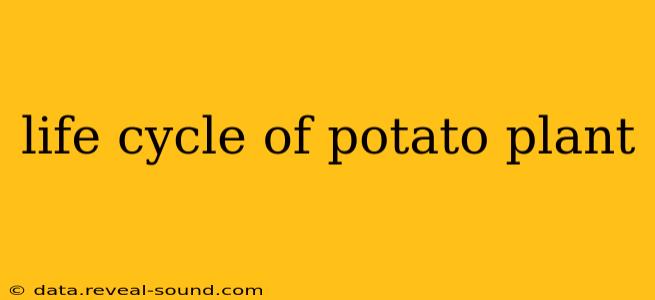The humble potato, a staple food worldwide, boasts a fascinating life cycle. Understanding this cycle, from the initial sprout to the harvest of mature tubers, provides valuable insight into optimal growing conditions and maximizing yield. This comprehensive guide delves into each stage, answering common questions along the way.
Stages of Potato Plant Growth
The potato plant's life cycle can be broadly divided into several key stages:
1. Seed Germination: The journey begins with the "seed," which is actually a small piece of potato, called a seed potato, containing "eyes" – buds that sprout into new plants. These seed potatoes are planted in well-prepared soil, typically in spring after the last frost. The ideal soil temperature for germination is around 45-55°F (7-13°C). Sufficient moisture is crucial for the seed potato to absorb water and initiate sprouting.
2. Sprouting and Emergence: Once planted and adequately watered, the eyes on the seed potato begin to sprout. Small shoots emerge from the eyes, pushing their way through the soil. This phase is sensitive to frost, which can severely damage or kill the emerging sprouts.
3. Vegetative Growth: This stage is marked by rapid growth of the plant's above-ground and below-ground parts. The plant develops stems, leaves, and a robust root system. The leaves are crucial for photosynthesis, converting sunlight into energy for growth. During this period, the plant requires ample sunlight, water, and nutrients from the soil.
4. Tuber Initiation and Development: This is where the magic happens. Underground, small swellings begin to form on the stolons (underground stems) – these are the beginnings of the potatoes we harvest. As the plant continues to grow, these swellings enlarge, accumulating starches and sugars to become the familiar tubers we know and love. This phase benefits from consistent watering and nutrient-rich soil.
5. Flowering and Pollination: Potato plants produce flowers, though the flowers themselves are not directly involved in potato production. Pollination, usually by insects, is important for seed production in true potato seeds, which are rarely used for commercial cultivation. The focus remains on the tuber development below ground.
6. Tuber Maturation and Harvesting: As the growing season progresses, the tubers continue to swell and mature. The skin becomes thicker, and the starch content increases. Harvesting typically occurs after the foliage has died back, often in late summer or early autumn. The timing depends on the specific variety and climate. Improper timing can lead to reduced yields and lower quality potatoes.
Frequently Asked Questions (Based on "People Also Ask" searches)
How long does it take for a potato plant to grow?
The time it takes for a potato plant to reach maturity varies depending on the variety, climate, and growing conditions. Generally, the entire process, from planting to harvesting, takes between 70 and 100 days.
What are the ideal growing conditions for potatoes?
Potatoes thrive in well-drained, loose soil with a slightly acidic pH (5.5-6.5). They need plenty of sunlight (at least 6-8 hours daily) and consistent moisture, though they don't tolerate waterlogged conditions. Adequate nutrients, especially potassium and phosphorus, are crucial for healthy growth and high yields.
How do you plant potatoes?
Seed potatoes should be planted about 4 inches deep and spaced 12-18 inches apart, depending on the variety. Rows should be spaced about 2-3 feet apart. Planting depth can vary slightly depending on the size of the seed potato.
What are some common potato diseases and pests?
Potatoes are susceptible to various diseases such as late blight, early blight, and verticillium wilt. Common pests include Colorado potato beetles, aphids, and nematodes. Proper crop rotation, disease-resistant varieties, and pest management practices can help mitigate these issues.
How do you store potatoes after harvesting?
Proper storage is crucial for maintaining potato quality. Potatoes should be cured in a cool, dark, and well-ventilated area for a few weeks after harvest. They should then be stored in a cool, dark, and dry place (around 45-50°F or 7-10°C) with good air circulation to prevent spoilage and sprouting.
This detailed exploration of the potato plant's life cycle provides a comprehensive understanding of this essential crop. By following best practices at each stage, growers can maximize their yields and enjoy a bountiful harvest. Remember to always consult local resources for specific advice tailored to your region and climate.
